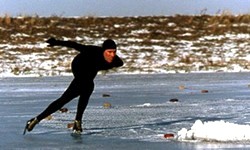 |
Fenland
ice
skating |
Fenland ice skating was one of the
most unusual sporting pursuits in the land because the weather needed to
be suitably cold and five nights of sub-zero temperatures were usually
reckoned to be sufficient to provide ideal conditions. Until that winter
day dawned, the long bladed skates known as fenland runners required for
such high speeds, hung optimistically in sheds and outhouses waiting for
the next big freeze. When it came, the thickness of the ice was all
important because there have been misjudgements in past years when
spectators and competitors have fallen through and so an official ice
tester of suitable weight was sent out to jump up and down on the surface
and if the ice held, then skating went ahead.
A telephone relay system was established to notify those who wished to
participate and the following day the competitors from all parts of the
country gathered on the ice for the races to begin over a triangular
course where the various outdoor speed skating championship titles for
Lincolnshire, for Fenland and even for Britain were decided.
The sport dates back to the Middle Ages and the earliest skaters were
almost certainly Flemish, using skates carved from wood or the shin bones
of sheep strapped tightly to their boots. Skating took place whenever the
frost was severe enough to prevent the land from being worked but provided
the ideal conditions on waterways and meres. Farm workers would skate
along the rivers and drains from pub to pub, often racing each other, and
so what was once a pastime soon became a working man's sport with prizes
of much needed food put up by the farmers such as a sack of potatoes or
even a joint of ham.
The speeds that could be achieved when miles of waterway were suddenly
opened up in this way were quite phenomenal and there are records of a
15-mile race from Wisbech to Whittlesey in Cambridgeshire in 1763 with a
winning time of 46 minutes. But the hey day of this winter pursuit was
during the 19th century after 15-inch steel blades were introduced and the
popularity of the sport led to the formation of the National Skating
Association in 1879 followed by the Lincolnshire Skating Association in
1890 to organise its own events within the county. The sport developed and
prospered and its existence became
manifest whenever the temperatures dipped to below freezing point for a
prolonged period, for this was one of the only sports in the land in which
participants prayed for a long, hard winter. The enthusiasm shown by skaters when
conditions were right is amply demonstrated by these news reports from the
Stamford Mercury:
During the latter part of last week, a
considerable number of skaters availed themselves of the opportunity
afforded them by the river Eau being frozen over. On Saturday, a match
took place on the ice, money prizes being given, the amount being
collected from various subscribers by Mr J R Bettinson, of Bourne Fen. In
the final heat, Brudenell succeeded in obtaining first place, Bradley
being second and Pulford third. - Friday 18th December 1885.
The fenland is now alive with skaters. The
Bourne Eau, the River Glen and the large drains are ice-bound and afford
an almost unlimited field of enjoyment for this favourite winter pastime.
– Friday 12th January 1894.
On Thursday week, the ice was strong enough for
skating but this did not become general on the Bourne Eau until Friday.
The dykes in every part were safe and provided a ready means of reaching
the river where the ice was excellent with an odd place here and there
that was somewhat rough. On reaching Tongue End, most of the skaters
crossed over to the Counter Drain where the ice was in better condition
for a distance of over six miles to Pode Hole. On Saturday, there were
many skaters on the river and quite a number proceeded to the Wash at
Spalding to witness the championship racing. On Sunday, there were a large
number down the river, the ice being in good condition despite the thaw.
Owing to water being pumped into the Counter Drain, skating was made
impossible and as the day wore on, the ice became worse and consequently
weaker and before the afternoon was over there were several immersions.
The ponds at Grimsthorpe also provided some splendid ice for skaters and
several from Bourne visited the ponds on Saturday. It is several years
since the ice was in such good condition. - Friday 1st February 1907.
The popularity of ice skating was so
accepted in the Bourne area that boys often stayed away from school when
sub-zero temperatures created the right conditions. This happened early in
1880 although the headmaster of the Bourne Council School in Star Lane
(now Abbey Road), Joseph J Davies, appears to have taken a tolerant view
of his pupils being absent from the classroom for this purpose because he
wrote in his log book on January 29th:
"Attendance very low today. Many boys away
skating and the ice is perfectly safe and they fear the frost will not
continue too long. Cold weather always increases the attendance as there
is no work then for the boys but when the ice becomes perfectly safe, a
dozen to twenty boys are absent every noon with leave from their parents
to go skating. Skating is a passion with Lincolnshire boys and indeed men."
A favourite venue for skating in recent years
was Baston Fen, near Bourne, where until recent years, thirty acres of the
nature reserve had another use in winter when the area was specially
flooded in anticipation of severe overnight frosts that would create the
ideal venue for ice skating by a dedicated band of enthusiasts who were
only able to pursue their sport when the weather was cold enough.
The tradition continued until recent years and every winter, thirty acres
of marshland at the Baston Fen nature reserve, four miles south of Bourne,
were flooded to a depth of several inches and then the Lincolnshire
Skating Association which organised the event waited for a sufficiently
long cold spell that would provide the right conditions for skating to
proceed on a suitable thickness of ice. Overnight frosts for at least a
week were required for the best results because officials were perpetually
aware that a wrong calculation could lead to a similar disaster to that
which occurred in the early 20th century when there were so many skaters
and spectators crammed on the ice that it broke under the weight and most
of them got a very cold ducking.
The association therefore employed an official ice tester, who in my time
forty years ago, was Bert Slater, a big and burly haulage contractor from
Crowland, who arrived when alerted to test the ice for strength with the
simple and straightforward method of jumping up and down on it in his
heavy boots at various vantage points, and if it held without the sign of
a crack, then the signal went out for skating to commence the following
day, provided the cold snap lasted. Whenever temperatures plunged below
zero for any length of time, Bert's activities captured the imagination of
the world's press with headlines such as "The Iceman Cometh" as he went
about his duties, but once he declared the ice fit for skating, the
telephones began buzzing, calling up everyone who wanted to be out on the
ice, whether for pleasure or for sport, and soon Baston Fen resembled one
of those old picture postcards or oil paintings of skaters thoroughly
enjoying themselves.
There was also the racing when competitors from all parts of the country
gathered on the ice for the events to begin, always over a distance of one
mile on a triangular course, to decide the various outdoor speed skating
championship titles for Lincolnshire, for Fenland and even for Britain.
The tradition had become so entrenched that grand silver shields and cups
were on offer for the winners, handed down through the years, from
generation to generation.
Unfortunately, this age old winter pursuit ended at Baston Fen in 1993
when the Lincolnshire Skating Association which organised it were forced
to abandon the periodic events because of crippling insurance charges.
Pleasure skating continued for a few more years but the owners of the
land, the Lincolnshire Wildlife Trust, faced similar difficulties with
their insurers over public liability and so skating for fun also ended in
2003 although there are still some who take to the ice when the weather
conditions are right but they do so at their own risk. Fenland skating,
however, continues to attract an enthusiastic following at venues in
Norfolk and Cambridgeshire whenever the weather is cold enough.
|
PICTURE GALLERY |
|
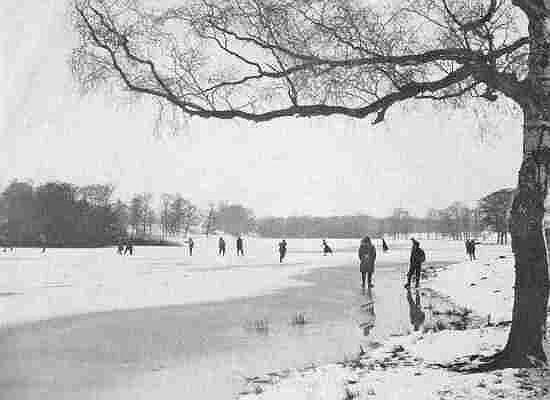
Ice skating at Grimsthorpe during January 1948 |
|
In March 1955, the secretary of the
Lincolnshire Skating Association, Mr Harry Gibb, of Spalding, fell
through the ice at Grimsthorpe Lake while testing the surface to
decide whether it was suitable for competition skating. The
committee had already declared that it was not but he disagreed and
decided to make a further inspection. Unfortunately, the thaw had
set in and as he weighed 18 stones, the ice gave way and he fell
through and was left struggling in a hole with water up to his
armpits. Mr Gibb managed to elbow himself out and back to the safety
of stronger ice and then, still sucking his pipe, crawled to the
bank unaided. He was taken for a warm bath and hot drinks at a house
in Bourne and was otherwise unhurt but confirmed that ice skating
should definitely be abandoned for the day. |
|
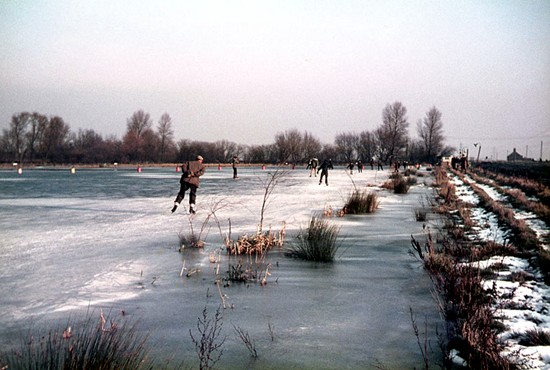 |
|
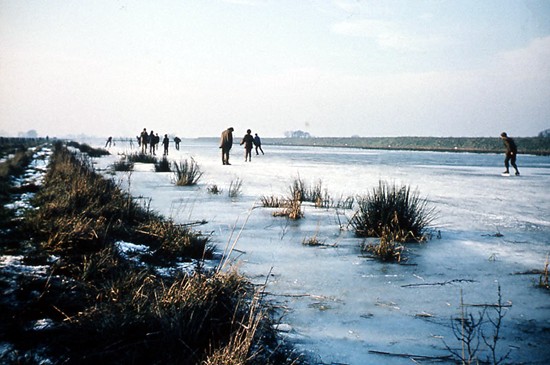 |
|
The top two pictures show pleasure skating at
Baston Fen in 1968-69 and the bottom photograph is of John French winning the 1½
mile championship race there in January 1982. |
|
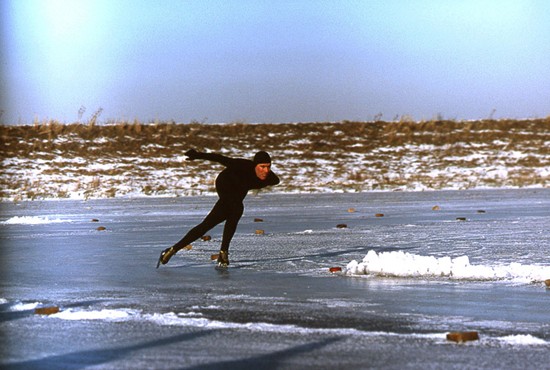 |
|
FROM THE ARCHIVES
On Tuesday last, an inquisition [inquest] was
taken before Francis Holland, gent., a coroner for this county, on
view of the body of Jarvis Lank who was skating on the Counter Drain
and ran into part of the drain which was not frozen and was drowned.
He was only 22 years old, a shepherd to Mr Digby of Bourne, and bore
a good character.
- news report from the Lincoln, Rutland and Stamford Mercury,
20th January 1792. |
REVISED DECEMBER 2011
See also
Baston Fen Nature Reserve
Praying for a cold hard winter

Go to:
Main Index Villages
Index
|




